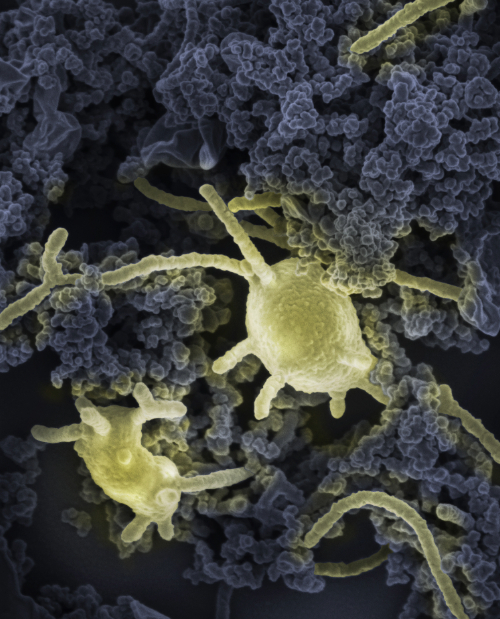Origins of eukaryotes, causes of food poisoning and degradation of polymers
Posted on August 1, 2024 by Clare Baker
Each month, the Microbiology Society publishes the International Journal of Systematic and Evolutionary Microbiology, which details newly discovered species of bacteria, fungi and protists. Here are some of the new species that have been discovered and the places they've been found.
Three new species of bacteria were discovered by one of our members from Teesside University. Campylobacter devanensis, Campylobacter porcelli and Campylobacter vicugnae, which are named after Aberdeen, Scotland, pigs and camelids, were discovered during a study which involved sequencing 7,000 bacterial isolates of Campylobacter to identify different causes of food poisoning.
The story of our next new microbe sounds like something straight out of a sci-fi movie (or from Greek mythology, if you’re a bit more cultured than I am). This archaeon was isolated from deep-sea sediment of the Nankai Trough off the Kumano area, Japan and was given probably one of the coolest names we’ve seen in New to Science - Promethearchaeum syntrophicum. It was named after ‘Prometheus’, the god who shaped humans out of mud and gave them the ability to create fire. The coolness doesn’t stop there! This anaerobic archaeon is pretty special, it’s the first isolate of the lineage ‘Asgard’ archaea – an archaeal group thought to be related to the origin of eukaryotes. P. syntrophicum is also more specifically affiliated with a class-level lineage called ‘Lokiarchaeota’.

Let’s move on from mythology and sci-fi now, and to the Tibetan antelope (Pantholops hodgsonii). This is ‘New to Science’ though, so we’re not looking at the beautiful antelope, we’re looking at the soil around it and its’ poo for new microbes. Nocardioides bizhenqiangii and Nocardioides renjunii are two new short rod-shaped bacteria isolated from the Qinghai-Tibet Plateau of PR China. The two species are named in honour of Zhenqiang Bi (former director of Shandong Center for Disease Control and Prevention) and Jun Ren (former director of Anhui Center for Disease Control and Prevention) for their excellent work on chronic disease control prevention and infectious disease control and prevention respectively.
Shall we move from one intestine to another? Sphingobacterium tenebrionis is a new species of bacteria, which was isolated from the intestine of a mealworm. Mealworms are the larvae of Tenebrio molitor, also known as the yellow mealworm beetle. These little insects are quite useful as they not only serve as a dietary source for birds, reptiles and other small pets, they also have recently gained attention for their ability to degrade plastic wastes. It was this trait that researchers were investigating when they discovered S. tenebrionis. They conducted a genome analysis to understand the potential enzymes responsible for polyurethane degradation. Analysis revealed the presence of 24 enzymes — notably 16 esterases and four amidases which possessed the critical characteristic of degrading polymers.
It would be nice to finish on something cute, how about rabbits? Neisseria leonii is our new bacterium isolated from our fluffy friends. Don’t get too attached to these rabbits though, as this non-motile, Gram-stain-negative strain was isolated from the nose, lung and liver of French and Swiss rabbits deposited at the Collection of Institut Pasteur (CIP) in 2002, 1987 and 2023. The new strain, and the two other known strains of bacteria isolated alongside it are expected to be valuable for future research on the ecology, evolution and virulence of Neisseria. As rabbits are also commonly used as animal models, the strains will aid in studying host-microbe interactions.

